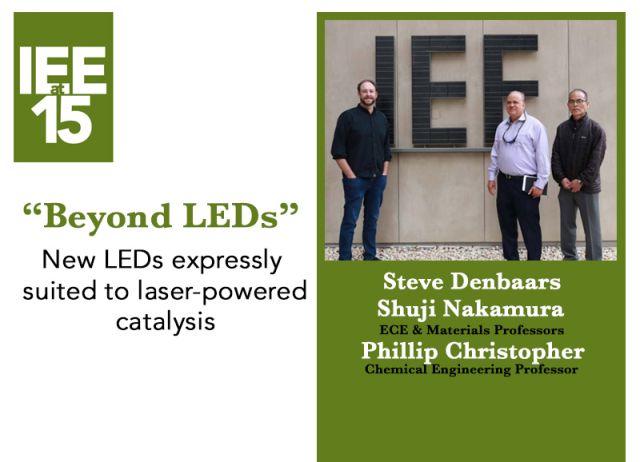IEE at 15 – LEDs
Shuji Nakamura and Steve DenBaars continue work to increase the efficiency of LED lighting

Excerpt from the COE Convergence article "The Institute for Energy Efficiency at 15" (pg. 15)
The IEE was created as existentially significant questions about environmental sustainability were coming into sharper focus and becoming a larger part of the global conversation. The challenges presented have only deepened in the years between the institute’s founding and its fifteenth anniversary.
This segment from "The IEE at 15" presents a glimpse from the universe of research in the institute undertaken by ECE faculty.
"Beyond LEDs"
Light-emitting diodes (LEDs) occupy an important place in the IEE. UCSB materials professor Shuji Nakamura won his Nobel Prize for inventing the blue LED, which enabled the white LED and the ensuing world-wide revolution in lighting efficiency. LEDs also led to lasers, which are now being used to generate all sorts of efficiency gains.
Steve DenBaars and Nakamura have worked steadily since the 1990s to increase the efficiency of LED lighting, which is projected to have prevented approximately 200 million tons of CO2 from entering the atmosphere by 2030. Their collaboration with Phillip Christopher to develop lasers is the kind of interdisciplinary project that would occur in only a few places, where no silos separate research that, on first glance, might appear unrelated.
While light-powered catalysis is not new, until now it has been done using off-the-shelf lasers that are not designed for catalysis and, therefore, do not achieve optimal efficiency. DenBaars and Nakamura, co-directors of SLEEC, a consortium linking industry and academia and dedicated to developing powerful energy-savings through technology, are designing new LEDs expressly suited to laser-powered catalysis in terms of wavelength, on-off modulation rate, and directional control of emitted light.
“Chemical processes take a lot of energy,” Bowers notes. “You can cook an egg by boiling water, but that’s really inefficient. But if I shine the right wavelength of light at the egg, it will absorb one hundred percent of the light and cook in no time. That’s kind of what Phil, Steve, and Shuji are doing. It could have huge implications in terms of making an energy-intensive process much more efficient.”
One possible application of that research is in making hydrogen without releasing emissions. Christopher explains that some people do that by cracking ammonia (NH3 ) to release hydrogen and benign nitrogen gas. An immediate goal of the research is “to tailor the LED laser operation to promote the energy efficiency of this reaction.”
“Hydrogen has the potential to be a great emission-free transportation fuel,” Bowers notes, “and if you can make it efficiently, that could have a huge impact on our society and on the world.”
COE/CLS Convergence magazine (Summer 2024) - "The IEE at 15" (full article pgs. 12-17)